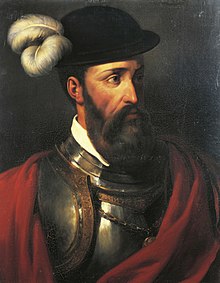Francisco Pizarro
Francisco Pizarro González, Marqués de los Atabillos (16 March 1478 – 26 June 1541) was a Spanish conquistador. Today, he is known as the conqueror of the Inca Empire. He also founded Lima, La Ciudad de los Reyes, capital of Peru. Pizarro was born in Trujillo, Extremadura, Spain.[2]
Francisco Pizarro | |
|---|---|
 Portrait of Francisco Pizarro by Amable-Paul Coutan, 1835 | |
| 1st Governor of New Castile | |
| In office 26 July 1529 – 26 June 1541 | |
| Monarch | Charles I |
| Succeeded by | Cristóbal Vaca de Castro |
| Captain General of New Castile | |
| In office 26 July 1529 – 26 June 1541 | |
| Personal details | |
| Born | 16 March 1478 Trujillo, Crown of Castile |
| Died | 26 June 1541 (aged 63) Lima, New Castile |
| Cause of death | Assassination by stabbing |
| Spouse(s) | Inés Huaylas Yupanqui |
| Children | Francisca Pizarro Yupanqui |
| Signature |  |
| Military service | |
| Nickname(s) | Apu ("chief" in Quechua) or Machu Capitan ("Old Captain" in Quechua)[1] |
| Allegiance | |
| Years of service | 1496–1542 |
| Battles/wars | Spanish conquest of Peru |
Family change
He was an illegitimate son of Gonzalo Pizarro Rodríguez de Aguilar (senior) who as colonel of infantry served in the Italian campaigns under Gonzalo Fernández de Córdoba, and in Navarre, with some distinction. His mother was Francisca González Mateos, a woman of slender means from Trujillo. Through his father, Francisco was second cousin to Hernán Cortés, the famed conquistador of Mexico.
Conquests change
In 1502, Pizarro traveled to the New World where he joined in several expeditions to see the Pacific Ocean. In 1513 Pizarro joined the expedition of Vasco Núñez de Balboa across the Isthmus of Panama to become one of the first Europeans to see the Pacific Ocean. In 1524, after hearing stories about the exploration of Peru, he joined Diego de Almagro and Hernando de Soto. Together, they agreed to travel to Peru and look for gold. Despite the expedition ending in failure, Pizarro managed to make connections with the Inca people.[3]
In 1528 he returned to Spain, where the king allowed him to conquer the new land for Spain. Pizarro himself was to be named governor of Peru. In 1531 he landed in Peru again, leading fewer than 300 soldiers. The country was devastated by a recent civil war between Atahualpa and Huascar, the sons of the dead emperor. In November 1532, Pizarro met Atahualpa in the city of Cajamarca and managed to capture him, even though the Inca was protected by thousands of soldiers. The weapons of the Spaniards proved superior. In 1533, after paying a huge ransom for his release, Atahualpa requested to be let free but Pizarro killed him anyway. He then continued south into Peru and captured the capital of Cuzco.
In 1535, Pizarro founded a new capital named La Ciudad de los Reyes, today known as Lima. However, some Spaniards had not been part of the capture of the Inca and therefore had not been paid any gold. Led by Almagro, the Almagristas, Almagro's men, marched south into present-day Chile to find new riches, while Pizarro stayed in Peru. The Inca were treated very poorly and their riches stolen by the Spaniards, who built huge estates or brought gold back to Spain.
In 1536, the Inca tried to overthrow him in a rebellion, but failed since Pizarro managed to subdue the Incas after a year of fights.
However, the Spaniards had became so weakened that when Almagro returned, he took power and expelled Pizarro to the north. Pizarro returned with an army in 1538 and defeated Almagro. Almagro was executed in the plaza of Cuzco and Pizarro was again sole ruler.
Death change
However, Almagro had a son who swore revenge, and in 1541, Pizarro was assassinated in his palace in Lima by a number of men following Diego Almagro the younger. He was himself caught and executed the following year, so was the last brother of Pizarro struggling for power in Peru, in 1548. Then the Spanish king took personal control over the country by a personal envoy, the Viceroy.
References change
- ↑ Cúneo-Vidal, R.: «Los hijos americanos de los Pizarros de la conquista.»
- ↑ "Francisco Pizarro". HISTORY. Retrieved 2020-06-08.
- ↑ "Francisco Pizarro". Biography. Retrieved 2020-06-08.
Related pages change